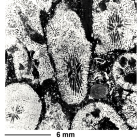Scleractinia taxon details
Blastozopsammia Filkorn & Pantoja Alor, 2004 †
1439893 (urn:lsid:marinespecies.org:taxname:1439893)
accepted
Genus
Blastozopsammia guerreroterion Filkorn & Pantoja Alor, 2004 † (type by original designation)
marine, fresh, terrestrial
fossil only
Filkorn HF, Pantoja Alor J. (2004). A new Early Cretaceous coral (Anthozoa; Scleractinia; Dendrophylliina) and its evolutionary significance. <em>Journal of Paleontology.</em> 78 (3): 501-512., available online at https://doi.org/10.1666/0022-3360(2004)078<0501:aneccd>2.0.co;2 [details]
Hoeksema, B. W.; Cairns, S. (2025). World List of Scleractinia. Blastozopsammia Filkorn & Pantoja Alor, 2004 †. Accessed at: https://marinespecies.org/scleractinia/aphia.php?p=taxdetails&id=1439893 on 2025-09-10
Date
action
by
original description
Filkorn HF, Pantoja Alor J. (2004). A new Early Cretaceous coral (Anthozoa; Scleractinia; Dendrophylliina) and its evolutionary significance. <em>Journal of Paleontology.</em> 78 (3): 501-512., available online at https://doi.org/10.1666/0022-3360(2004)078<0501:aneccd>2.0.co;2 [details]
additional source Baron-Szabo, R.C. & S.D. Cairns. (2019). Chapter 14: Part F, Revised, Volume 2, Chapter 14:Systematic Descriptions of the Scleractinia Family Dendrophylliidae. <em>Treatise Online, Part F, Revised.</em> 119: 1-33. [details] Available for editors
additional source Baron-Szabo, R.C. & S.D. Cairns. (2019). Chapter 14: Part F, Revised, Volume 2, Chapter 14:Systematic Descriptions of the Scleractinia Family Dendrophylliidae. <em>Treatise Online, Part F, Revised.</em> 119: 1-33. [details] Available for editors
 Present
Present  Inaccurate
Inaccurate  Introduced: alien
Introduced: alien  Containing type locality
Containing type locality
From editor or global species database
Diagnosis Corallum colonial, attached (?), ramose; budding extracalicinal; corallites small, monocentric, dimorphic; each branch consists of one axial corallites with smaller secondary corallites budded laterally and arrayed radially from this axis of branch; septa laminar, imperforate, typically hexamerally arranged in three complete cycles, with pairs of S4 sometimes present; septa in weakly developed or incipient Pourtales plan’ columella weakly developed, appears as trabecular segments or loosely spongy; pali (?) or paliform lobes (?) may be present on S2; wall synapticulothecal; endothecal dissepiments sparse (‘dissepiments absent’ according to the original description but a small number of thin vesicular dissepiments seem to be present in the type material); coenosteum reticulate, relatively thick, extensive; coenosteal surfaces granular, porous, weaklt costate or striate, spinose. [details]
